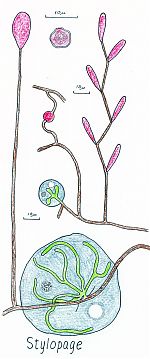Stylopage
STYLOPAGE Drechsler, 1935 (Mycologia 27:197), 15 species (Drechsler, 1935a).
Predaceous on amoebae and, less commonly, nematodes. Trap host by secretion of a sticky substance. Haustoria produced in the host, vegetative and reproductive hyphae produced externally. One or several asexual propagules produced on relatively long sporangiophores. Merosporangia unispored, obovoid, broadly ellipsoid, lunate, or falcate, with or without an apical appendage. Zygospores more or less globose, with a warty or cupulate zygosporangium; suspensors hyphoid, more or less equal.
Type species: S. haploe
Species of Stylopage:
S. anomala Wood, 1983 (Transactions of the British Mycological Society 80:368) (Wood, 1983; Blackwell and Malloch, 1991).
S. apsheronica Islamov, 1981 (Mikologiya i Fitopatologiya 15:5) (Islamov, 1981).
S. araea Drechsler, 1935 (Mycologia 27:201) (Drechsler, 1935a, 1939).
S. araea var. magna Peach & Juniper, 1955 (Transactions of the British Mycological Society 38:431) (Peach and Juniper, 1955; Jones, 1962).
S. cephalote Drechsler, 1938 (Mycologia 30:147) (Drechsler, 1938, 1942, 1946; Jones, 1959).
S. cymosa Duddington, 1953 (Annals of Botany 17:129) (Duddington, 1953).
S. gracilis Mekhtieva & Islamov, 1979 (Mikologiya i Fitopatologiya 13:469) (Mekhtieva & Islamov, 1979).
S. grandis Duddington, 1955 (Mycologia 47:247) (Duddington, 1955a).
S. hadra Drechsler, 1935 (Drechsler 27:209) (Drechsler, 1935b).
S. haploe Drechsler, 1935 (Mycologia 27:199) (Drechsler, 1935a; Duddington, 1955b; Jones, 1959, 1962).
S. leiohypha Drechsler, 1936 (Mycologia 28:244) (Drechsler, 1936a)
S. leptae Drechsler, 1935 (Mycologia 27:202) (Drechsler, 1935a; Jones, 1959; Juniper, 1953; Mektieva, 1965).
S. minutula Drechsler, 1945 (Mycologia 37:18) (Drechsler, 1945)
S. rhabdoides Drechsler, 1947 (Mycologia 39:262) (Drechsler, 1947; Duddington, 1955b; Jones, 1959).
S. rhabdospora Drechsler 1936 (Mycologia 28:377) (Dayal and Srivastava, 1979; Drechsler, 1936b, 1946; Jones, 1959, 1962; Miura, 1972; Saikawa, 1986).
S. rhicnacra Drechsler, 1948 (Mycologia 40:102) (Drechsler, 1948; Duddington, 1951b).
S. rhynchospora Drechsler, 1939 (Mycologia 31:396) (Drechsler, 1939, 1959; Duddington, 1951a; Juniper, 1953; Jones, 1959).
S. scoliospora Drechsler, 1939 (Mycologia 31:391) (Drechsler, 1939).
Drechlser (1935b) found that Sylopage hadra appeared in culture five to 15 days after a culture that already contained nematodes was inoculated with lead mold. These fungi produce a single merosporangium or several in succession on an erect sporangiophore (Drechsler, 1935a). Stylopage leiohypha Drechsler, 1936a) was isolated one to three weeks after soil was placed on a plate already containing nematodes. In S. rhabdospora zygospores were produced in crosses between two distinct hyphae or two germinating spores, or between a hypha and a germinating spore (Drechsler, 1936b). Drechsler (1938) described S. cephalote which produces several mrosporangia from the vesiclate apex of a long sporangiophore. This fungus appeared in May after laboratory temperature was elevated above that normally condusive for growth of other zoopagaceous taxa; S. cephalote is a parasite of amoebae. Zygospores of S. cephalote have a cupulate wall (Drechsler, 1938) whereas those of S. rhynchospora (Drechsler, 1939) are ornamented with hemispherical warts. Merosporangia of the latter species, and S. rhinacra (Drechsler, 1948) have an apical appendage. The other species of Stylopage described do not produce appendages. Drechsler (1959) reported that S. rhynchospora appeared several times in the two decades since it was first described (Drechsler, 1939) and its distribution extends from Florida to Wisconsin.
Bibliography
Blackwell, M., and D. Malloch. 1991. Life history and arthropod dispersal of a coprophilous Stylopage. Mycologia 83:360-366.
Dayal, R., and S.S. Srivastava. 1979. A few zoopageous species destructive to soil amoebae. Indian Phytopathology 32:397-400.
Drechsler, C. 1935a. Some non-catenulate conidial Phycomycetes preying on terricolous amoebae. Mycologia 27:176-205.
Drechsler, C. 1935b. A new species of conidial Phycomycetes preying on nematodes. Mycologia 27:206-215.
Drechsler, C. 1936a. A new species of Stylopage preying on nematodes. Mycologia 28:241-246.
Drechsler, C. 1936b. New conidial Phycomycetes destructive to terricolous amoebae. Mycologia 28:363-389.
Drechsler, C. 1938. New Zoopagaceae capturing and consuming soil amoebae. Mycologia 30:137-157.
Drechsler, C. 1939. Five new Zoopagaceae destructive to rhizopods and nematodes. Mycologia 31:388-415.
Drechsler, C. 1942. New species of Acaulopage and Cochlonema destructive to soil amoebae. Mycologia 34:274-297.
Drechsler, C. 1945. Several additional Phycomycetes subsisting on nematodes and amoebae. Mycologia 37:1-31.
Drechsler, C. 1946. Three new Zoöpagaceae subsisting on soil amoebae. Mycologia 38:120-143.
Drechsler, C. 1947. Three zoöpagaceous fungi that capture and consume soil-inhabiting rhizopods. Mycologia 39:253-281.
Drechsler, C. 1948. Three Zoopagaceae that subsist by capturing soil amoebae. Mycologia 40: 85-105.
Drechsler, C. 1959. Several Zoopagaceae subsisting on a nematode and some terricolous amoebae. Mycologia 51:787-823.
Duddington, C.L. 1951a. Further records of British predaceous fungi. II. Transactions of the British Mycological Society 34:194-209.:
Duddington, C.L. 1951b. The ecology of predaceous fungi. I. Preliminary survey. Trans. Brit. Mycol. Soc. 34:322-331.
Duddington, C.L. 1953. A new species of Stylopage capturing amoebae in dung. Annals of Botany, n.s., 17:127-129.
Duddington, C.L. 1955a. A new species of Stylopage capturing nematodes. Mycologia 47:245-248.
Duddington, C.L. 1955b. Some observations on the Zoopagaceae. Quekett Microscopical Club Journal, Series 4, 8:160-163.
Islamov, E.M. 1981. NovyÄ vid amebofagovogo griba — Stylopage apsheronica Islamov sp. nov. (Entomophthorales) [A new species of amoebophagus fungus, Stylopage apsheronica Islamov sp. nov. (Entomophthorales)]. Mikologiya i Fitopatologiya 15(1): 5-6.
Jones, F.R. 1959. Some Zoopagales from Kenya. Transactions of the British Mycological Society 42:75-89.
Jones, F.R. 1962. New English Zoopagales. Transactions of the British Mycological Society 45:348-358.
Juniper, A.J. 1953. Some predaceous fungi occuring in dung. Transactions of the British Mycological Society 36:356-361.
Mekhtieva, N.A., and E.M. Islamov. 1979. NovyÄ vid amebofagovogo griba –_ Stylopage gracilis_ Mecht, et Islamov sp. nov. [A new species of an amoebophagus fungus, Stylopage gracilis Mecht, et Islamov sp. nov]. Mikologiya i Fitopatologiya 13(6):475-479.
Mektieva, N.A. 1965. O nakhozhdenii Stylopage v Azerbaidzhane. Doklady, Akademia Nauk Azerbaidzhanskoi SSR 21(3):84-86.
Miura, K. 1972. Notes on filamentous fungi from Japan (9) The genus Cochlonema (Zoopagales). Journal of Japanese Botany. 47:204-214.
Peach, M., and A.J. Juniper. 1955. Stylopage araea Drechsler var. magna var. nov. Transactions of the British Mycological Society 38:431-434.
Saikawa, M. 1986. Ultrastructure of Stylopage rhabdospora, an amoeba-capturing zoopagaceous fungus. Mycologia 78:309-312.
Wood, S.N. 1983. Stylopage anomala sp. nov. from dung. Transactions of the British Mycological Society 80:368-370.
Updated Nov 05, 2007

